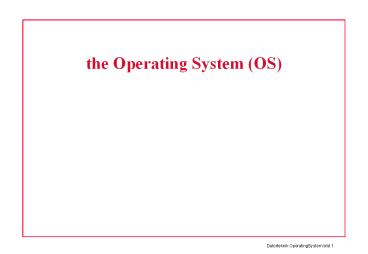the Operating System (OS) - PowerPoint PPT Presentation
1 / 28
Title:
the Operating System (OS)
Description:
How does the User program pass control to the Operating System? Take control on ERROR ... Address. 12 Status Register. 13 Cause Register. 14 Exception Address ... – PowerPoint PPT presentation
Number of Views:13
Avg rating:3.0/5.0
Title: the Operating System (OS)
1
the Operating System (OS)
2
The Operating System (OS)
Operating System
P1 Editor
P2 Compiler
P3 Quake Arena
MIPS
At any one time the processor (MIPS) is only
excecuting one program (process).
3
The Operating System (OS)
Operating System
P1 Editor
P2 Compiler
P3 Quake Arena
MIPS
At any one time the processor (MIPS) is only
excecuting one program (process).
4
The Operating System (OS)
Operating System
P1 Editor
P2 Compiler
P3 Quake Arena
MIPS
At any one time the processor (MIPS) is only
excecuting one program (process).
5
The Operating System (OS)
Operating System
P1 Editor
P2 Compiler
P3 Quake Arena
MIPS
At any one time the processor (MIPS) is only
excecuting one program (process).
6
The Operating System (OS)
Operating System
P1 Editor
P2 Compiler
P3 Quake Arena
MIPS
At any one time the processor (MIPS) is only
excecuting one program (process).
7
Our Assembler
.text
.data
User
.kdata
.ktext
Kernel
8
The Hardware
.text
.data
User
ERROR!
OK
.kdata
.ktext
Kernel
9
How does the User program pass control to the
Operating System?
- Take control on ERROR
- Pass control explicitly
10
ERROR
- Ex, Arithmetical Overflow
- li 4 0x80000000
- neg 4 4
- (sub 4 0 4)
- 0x00000000
- - 0x80000000
- 0x80000000
Sign differs
Same Sign ! ERROR
11
Signed/Unsigned Arithmetics
- The only difference is that
- Unsigned never causes ERROR
- Signed causes ERROR on Overflow etc.
Signed ADD SUB ADDI ..
Unsigned ADDU SUBU ADDIU ..
12
Memory Error
- Instruction Memory Bad PC
- Data Alignment Error
- Access Protected Memory from User mode
- Nonexistent Memory
- (Page fault Chapter 7)
13
Do not confuse !
- A Memory that tells the pipeline to Wait
- relate to cache miss
- A Memory Error or Page Fault
- relate to TLB miss
14
The Consequence
- A Memory that tells the pipeline to Wait
- Pipeline Stall
- A Memory Error or Page Fault
- Exception
15
Pass Control Explicitly
- The User wants some service from the Operating
System - File I/O
- Graphics
- Sound
- Allocate Memory
- Terminate Program (no HALT instruction in real
MIPS) - SYSCALL (causes an exception)
16
How to choose service
- Is there different SYSCALLs?
- NO! Only one, use a register (a0) to choose
- Use other registers (a1,...) as parameters
- Use v0 for result
- ori a1 r0 A Char A
- ori a0 r0 0x00 Write Char
- syscall
- ori a0 r0 0x01 Read Char
- syscall
- or a1 r0 v0 Move result v0-gta1
- ori a0 r0 0x00 Echo Char
- syscall
17
Other ways for the Operating System to take
control?
- External Interrupts, (not caused by User program)
- Timers
- Harddisk
- Graphics
- Sound
- Keyboard, Mouse, other perhipals
18
Coprocessor CP0
- 8 Bad Memory Address
- 12 Status Register
- 13 Cause Register
- 14 Exception Address (EPC)
19
Status Register CP0 (12)
- Mode Stack
- External Interrupt enable/disable
20
Mode Stack
OLD
PREVIOUS
CURRENT
0
5
KU IE
KU IE
KU IE
0 Kernel Mode 1 User Mode 0 External Interrupt
Disable 1 External Interrupt Enable
KU IE
21
Exception / Interrupt Occurs
OLD
PREVIOUS
CURRENT
KU IE
KU IE
KU IE
KU IE
KU IE
0 0
0 Kernel Mode 1 User Mode 0 External Interrupt
Disable 1 External Interrupt Enable
KU IE
22
RFE Instruction (priviliged)
OLD
PREVIOUS
CURRENT
KU IE
KU IE
KU IE
? ?
KU IE
KU IE
We restore the PREVIOUS (KU,IE) into CURRENT
23
External Interrupts
- Bit 0, (Current Interrupt Enable)
- All External Interrupts Enable/ Disable
- Bit 15..10, (individual interrupt enable)
15
10
0
Current IE
INT 4
INT 3
INT 2
INT 1
INT 0
INT 5
............
24
Enable External Interrupt 2
- Bit 0 1, (External Interrupt Enabled)
- Bit 12 1, Interrupt 2 Enabled
15
10
0
INT 4
INT 3
INT 2
INT 1
INT 0
INT 5
Current IE 1
............
0
0
0
0
0
1
25
Cause Register (CP0 13)
- Bit 5..2, Exception Cause Code
- Bit 15..10, Interrupt Pending
- Bit 31, Exception Occur In Branch Slot
10
5
2
31
15
INT 5
INT 4
INT 3
INT 2
INT 1
Ex 3
Ex 2
Ex 1
Ex 0
BS
INT 0
....
....
...
Pending Interrupts
Exception Cause Code see LSI Logic Users Manual
26
Check if Interrupt 2 Pending
- Mask with bit 12
15
10
CP0 13
INT 4
INT 3
INT 2
INT 1
INT 0
INT 5
AND
0
0
0
0
0
1
0
0
0
0
0
INT 2
27
Resume User Program
- CP0 14 Holds the Exception Address
- (Addr to instruction in EX
stage) - mfc0 k0 14 resume address
- jr k0 k0 kernel reg
- rfe delayed branch
28
Shared Stack
- Assume that the User program uses the stack
- Can the Kernel use the same stack (sp)?
- Yes, but remember never to use memory below sp,
it will be destroyed (overwritten)!!
sp
Kernel Data
Kernel Data
sp
User Data
User Data
User Data
User Data































